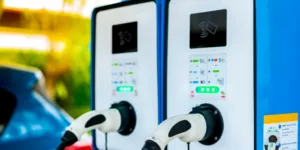With more electric vehicles on the road, businesses are installing EV (electric vehicle) charging stations to cater to these environmentally-conscious drivers.
The International Energy Agency projects that there will be 125 million EVs on the road, globally, by 2030. It’s only a matter of time before charging stations are the norm – not the exception – at retail stores, offices and other places of business.
But just like with any other investment, there are things that need to be considered before making the leap and installing EV charging stations.
1. There are Tax Advantages to Installing Charging Stations
Installing charging stations will undoubtedly cost you money, and cost is the biggest concern for most businesses. But there are tax advantages that may help offset these costs.
The Alternative Fuel Infrastructure Tax Credit provides a tax credit of 30% for the purchase and installation of EV charging stations (up to $30,000).
If you’re installing charging stations, you may be considering purchasing electric vehicles for your company fleet. If so, there’s a tax credit for this as well – up to $7,500 per new EV purchased in the United States. The size of the tax credit will depend on the size of the vehicle and its battery.
2. Your Electricity Bill Will be Impacted
Before installing charging stations, it’s important to assess the impact they will have on your electricity bill.
Choosing a time-of-use, or TOU, electric rate plan will optimize electricity savings. These plans offer cheaper rates during off-peak periods (typically late at night) and higher rates during high-demand times.
Some businesses may charge a fee for use during high-demand hours, but allow for free charging during off-peak hours. This type of a system could offset the costs of running the stations.
3. The Number and Placement of Stations is Important
How many charging stations will you install, and where will you install them? A small number of simple charging stations at multiple sites may be easier to manage and integrate into your infrastructure than installing a large number of stations at one site.
With that said, concentrating your charging in one place also makes it easier to capture value from EV flexibility and smart charging.
4. Charging Patterns Should be Considered
It’s important to consider the charging patterns of users when installing charging stations. These patterns will be highly dependent on the use of the stations. Will customers be using the station to charge their vehicle while they shop? Will you use the station to charge your own fleet? Will these stations be available to your employees?
If customers will be using the station, they will only be charging for a short period of time and won’t want their charging interrupted. But employees who will be charging their vehicles all day may not mind if charging is delayed or interrupted at peak hours during the day.
5. The Connection Size is Important
If you plan to offer rapid charging stations or if you expect to charge multiple vehicles at once, you’ll need to consider your connection size.
Although a large connection will cost more, it will also allow you to meet a higher demand. There’s also the option of staggering the timing of vehicle charging to avoid a surge in power, otherwise known a smart charging.
6. Installing EV Stations Will Give You an Edge on the Competition
An estimated 25% of vehicle sales will be electric by 2025. That’s a quarter of all vehicle sales. Demand for charging stations is out there, and it will only increase in the next decade.
Installing charging stations now will give you an edge on the competition. It will help you attract and retain top talent while improving employee satisfaction. More importantly, these stations will help you meet your sustainability goals and establish your brand as a “green leader.”
Many businesses see an increase in the number of employees driving EVs after they install charging stations.
EVs are coming faster than you think, and it’s important for businesses to be prepared for an increased demand for charging stations. Employees and customers both will expect this type of perk in the not-so-distant future. Making the investment now will ensure that you’re ready to cater to staff and consumers driving EVs.








